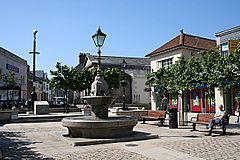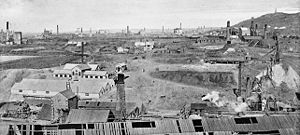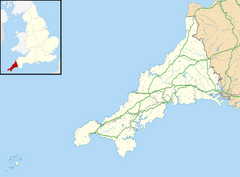| Main | Births etc |
|---|
| Camborne | |
| Cornish: Cambron | |
 Commercial Square, Camborne Town Centre |
|
| Population | 20,010 (2001) |
|---|---|
| OS grid reference | |
| Parish | Camborne |
| Unitary authority | Cornwall |
| Ceremonial county | Cornwall |
| Region | South West |
| Country | England |
| Sovereign state | United Kingdom |
| Post town | CAMBORNE |
| Postcode district | TR14 |
| Dialling code | 01209 |
| Police | Devon and Cornwall |
| Fire | Cornwall |
| Ambulance | South Western |
| EU Parliament | South West England |
| UK Parliament | Camborne and Redruth |
| List of places: UK • England • Cornwall | |
Camborne (Cornish: Cambron, 'Crooked Hill') is a town and civil parish in west Cornwall, United Kingdom. It is at the western edge of a conurbation comprising Camborne, Pool and Redruth .[1]
The population of Camborne was 20,010 at the 2001 census.[2] The population of the Camborne-Redruth urban area, which includes Pool and satellite villages, is 39,937,[3] making it the largest conurbation in Cornwall.
Camborne is located in what was formerly one of the richest tin mining areas in the world. It is no longer an industrial town but is still home to the Camborne School of Mines (see below).
History[]
In 1931 the ruins of a Roman villa were found at Magor Farm, Illogan, near Camborne, and excavated that year under the guidance of the Royal Institution of Cornwall.[4] It is the only Roman villa found as of 2006 in the whole of Cornwall.
An inscribed altar stone found at Camborne (now in the Church of St Martin and St Meriadoc), and dated to the tenth or eleventh centuries, attests to the existence of a settlement then.[5] Langdon (1896) records seven stone crosses in the parish of which two are at Pendarves.
Mining[]
Camborne is best known as a centre for the former Cornish tin and copper mining industry, having its working heyday during the later 18th and early 19th centuries. Camborne was just a village until transformed by the mining boom which began in the late eighteenth century and saw the Camborne and Redruth district become the richest mining area in the world. Although a considerable number of ruinous stacks and engine houses remain, they cannot begin to convey the scenes of 150 years ago when scores of mines transfigured the landscape.

Harriets Pumping Engine house, part of Dolcoath Mine, built in 1860
Dolcoath Mine, (English: Old Ground Mine), the 'Queen of Cornish Mines' was, at a depth of 3500 feet (1067 m), for many years the deepest mine in the world, not to mention one of the oldest before its closure in 1921. The last working tin mine in Europe, South Crofty, which closed in 1998, is to be found in Camborne.
[]
Holmans Rock Drill from 1955 (taken from the 55 vol. of CSM Magazine)
Apart from the mines themselves, Camborne was also home to many important related industries, including the once world-renowned foundry of Holman Bros Ltd (CompAir). Holmans, a family business founded in 1801, was for generations, Camborne's, and indeed Cornwall's largest manufacturer of industrial equipment, even making the famous Sten submachine gun for a stint during the Second World War. The Holman Projector was used by the Royal Navy. At its height Holmans was spread over three sites within Camborne, employing some three and half thousand men. Despite Britain's industrial decline, Compair Holmans Camborne factory finally closed in 2001.
On the Afternoon of Tuesday 5 December 2006, a wall of the Holmans factory was leaning towards the railway line, as a result the line west of Truro was closed for the afternoon and night and disrupting railway services, as it was feared the wall could callapse onto the mainline, part of the derelict factory was later demolished that night.
A modest quantity of South Crofty tin was purchased by a local enterprise and this gradually dwindling stock is used to make specialist tin jewellery, branded as the South Crofty Collection.
Camborne School of Mines[]
Because of the importance of metal mining to the Cornish economy, the Camborne School of Mines (CSM) developed as the only specialist hard rock education establishment in the United Kingdom, until the Royal School of Mines was established in 1851. Its beginnings can be traced to 1829 when plans for the school were first laid out and leading to the current school in 1888. It now forms part of the University of Exeter, and relocated to the University's Tremough campus in 2004. CSM graduates are to be found working in the mining industry all over the world. It has a very fine collection of minerals in its museum of geology.
Steam locomotion[]
On Christmas Eve 1801, the Puffing Devil - a steam-powered road locomotive built by Camborne engineer Richard Trevithick - made its way up Camborne Hill in Cornwall.[6] It was the world's first self-propelled passenger carrying vehicle. The events have been turned into a local song:
- Going up Camborne Hill, coming down,
- Going up Camborne Hill, coming down,
- The horses stood still,
- The wheels turn around,
- Going up Camborne Hill, coming down.
Trevithick was born in Penponds, in 1771, a miner's son, and was educated at Camborne School. His achievements (not to mention steam power, mining, and Cornish culture as a whole) are celebrated every last Saturday of April as the town's 'Trevithick Day', and by his statue standing outside Camborne public library.
Governance[]
The Camborne and Redruth constituency was created for the 2010 general election, following a review of parliamentary representation in Cornwall by the Boundary Commission for England, which increased the number of seats in the county from five to six.[7] It is primarily a successor to the former Falmouth and Camborne seat.
In the United Kingdom general election, 2010 the sitting Liberal Democrat MP, Julia Goldsworthy was defeated by the Conservative party candidate George Eustice with a narrow majority requiring a recount. The results for the three main political parties were:
- George Eustice (Conservative) 15,969)
- Julia Goldsworthy (Liberal Democrat) 15,903
- Jude Robinson (Labour) 6,945
Locally, the pro-Cornish party Mebyon Kernow (which favours a Cornish Assembly) has a large following in the area and recently became the largest political group on Camborne town council after a by-election .
Church history[]
Camborne's parish church is dedicated to St Martin and St Meriadoc: it is entirely of granite, of 15th century date and is listed Grade I. There is a western tower and the aisles are identical in design: an outer south aisle was added in 1878.[8] St Martin was added to the original dedication to St Meriadoc in the 15th century.
An inscribed altar stone found at Chapel Ia, Troon (now set in the altar of the parish church), and dated to the tenth or eleventh centuries, attests to the existence of a settlement then.[5] The chapel of St Ia was recorded in 1429 and a holy well was nearby. The site was called Fenton-ear (i.e. the well of Ia). The stone is very similar to one now in the garden at Pendarves, used as the base for a sundial.[9]
Camborne churchyard contains a number of crosses collected from nearby sites: the finest is one found in a well at Crane in 1896 but already known from William Borlase's account of it when it was at Fenton-ear. Two other chapels are known to have existed in the medieval period: one not far from the parish church was dedicated to Our Lady and St Anne and one at Menadarva (derived from Merther-Derwa) was one of Celtic origin dedicated to St Derwa, Virgin, but mentioned in 1429.[9]
Transport[]
The A30 trunk road now by-passes the Town around its northern edge. The old A30 through the Town has become the A3047. There is a small bus station half way along and to the south of Trelowarren Street (the main high street), which has featured in tales by Cornish comedian Jethro.
The railway station is a half-mile south from the town centre, with a level crossing and footbridge at its eastern end. Camborne station used to be famous for its short platforms, which meant that passengers on main line services between London and Penzance could only board and alight from certain carriages. Partly because of this not all services stopped at Camborne, preferring nearby Redruth station (which is also classed by FGW trains as a short station stop). The platforms have been upgraded but the memory lives on, again partly in stories by the comedian Jethro. Camborne station is served by CrossCountry and First Great Western trains.
Camborne was, for a while, home of Cornwall's only tram service. This system was opened in 1902 and ran a regular service to Redruth until it closed in 1927.
Sport[]
Camborne RFC were established in 1878 and are one of the most famous clubs in Cornwall, having produced numerous Cornwall players over the years. In 1987 Camborne were the highest placed Cornish club in the newly formed National leagues when they entered at Courage National Division 4 South level, (equivalent to National Division 3 South today). Camborne is one of the grounds used by the Cornish rugby team and has hosted many notable international sides including the New Zealand 'All Blacks' in 1905, 1924 and 1953, Australia in 1908, 1947 and 1967, South Africa 1960, United States 1977 and numerous other touring sides such as the South African Barbarians and Canterbury (NZ). Since 2006 it was agreed to ground share the Recreation Ground with local Division One team the Cornish Pirates and the ground has undergone major reburbishment including a new stand for the 2007-8 and 2008-9 seasons.[10]
Notable local rugby players include Josh Matavesi 18 year old debut for Fiji against Scotland in 2010, Roger Arthur, Llanelli and Wales and Andy Reed, Camborne, Bath, and Scotland.
Economy[]
Despite a poor reputation throughout much of Cornwall as a depressed region, the Camborne, Pool and Redruth district is currently at the entre of a £150 million redevelopment which hopes to reverse social and economic decline in this former industrial heartland.
CPR Regeneration[]
CPR Regeneration (CPRR), one of the government's 19 Urban Regeneration Companies (URCs) is overseeing a large urban renewal programme in the country on behalf of a range of partners including Cornwall Council, the South West of England Regional Development Agency and the Homes and Communities Agency. CPRR is tasked with driving the regeneration of former industrial land, attracting businesses and helping them create sustainable jobs; supporting local business growth ambitions and fostering employment growth through increasing the skills of those in and out of work. To date, as well as working on supporting businesses in the area—especially those in the town centres, CPRR has been engaged in the process of assembling sites, securing agreements with developers and doing enabling works for major projects such as the east-west link road between Redruth and Camborne.
A challenge faced by CPRR has been to work collaboratively with the owners of the South Crofty mine (which occupies a central position in the Pool regeneration area) to both allow mine development operations to continue and secure the re-development of the wider area around the mine. Stories did appear in the press regarding alleged illegal in-fill of ventilation shafts by CPRR. The truth—that English Partnerships had found old unmarked shafts on development sites which were in danger of collapse and made them good with concrete caps (removable if needed later by the mine company)--was lost. CPRR has continued to advance major projects in the area, such as a range of housing and infrastructure schemes, and will help the South West of England Regional Development Agency and the Homes and Communities Agency bring these forward shortly. Some of the work of the URC is becoming apparent, with works on the Pool Innovation Centre and the Trevenson Road area both advancing well.
Criticism of the Regional Development Agency[]
Local MPs have criticized the South West of England Regional Development Agency for interefering in the private sector, and said there maybe ulterior motives. Andrew George, MP for West Cornwall, said, "The RDA’s antics are at odds with the claims made to me by the Minister in Parliament and in a letter that the RDA ‘will be informed by the outcome of public consultation. I am astounded that a public body can be acting in such a predatory manner. The RDA seems to want to jump in where it is not wanted and yet it doesn’t intervene where it is. There are places like the Union Hotel in Penzance where the owner and local applicants would be grateful if the RDA were able to step in and purchase but the RDA says that it must be market tested first. Yet when they are faced with a Mine where the owners want to do something constructive, the RDA seem keen to intervene. The public sector has a role in supporting the private sector when projects are not able to be self sustaining. Public money and resources should not be used to undermine the efforts of the private sector".

View east from Dolcoath Mine, 1893
Music[]
- Camborne Town Band
Education[]
The town has a number of schools covering all age ranges, notably the main secondary school, Camborne Science and Community College, and a campus of Cornwall College.
Fiction[]
Alan M. Kent's 2005 novel Proper job, Charlie Curnow ! is set in and around the Trelawney Estate.
Twinning[]
Camborne is twinned with two places:
- Santez-Anna-Wened, Brittany, France
- Pachuca, Hidalgo, Mexico: Camborne was twinned with Pachuca at a ceremony in Mexico on 3 July 2008.[11]
See also[]
- The town name inspired the name of Camborne, New Zealand, a seaside suburb of Porirua City developed by an investment company headed by an Arthur Cornish. Most of its street names are of Cornish origin.
- Camborne Town Band
- Holman Climax Male Voice Choir, based in Camborne
References[]
- ^ Ordnance Survey: Landranger map sheet 203 Land's End ISBN 9780319231487
- ^ "Census 2001 : Parish Headcounts : Camborne Civil Parish". Office for National Statistics. 2001. http://neighbourhood.statistics.gov.uk/dissemination/LeadTableView.do?a=3&b=792785&c=Camborne&d=16&e=15&g=430273&i=1001x1003x1004&m=0&r=1&s=1196872830875&enc=1&dsFamilyId=779. Retrieved 2007-12-05.
- ^ "Census 2001: Key Statistics for Urban Areas in England and Wales" (PDF). Office for National Statistics. 2004. http://www.statistics.gov.uk/downloads/census2001/ks_ua_ew_part1.pdf. Retrieved 2007-12-05.
- ^ B.H. St. J. O'Neil, "Roman villa in Cornwall", Antiquity 5 (1931), pp .494-5, with photographs
- ^ a b See the discussion and bibliography in Elisabeth Okasha, Corpus of early Christian inscribed stones of South-west Britain (Leicester: University Press, 1993), pp.82-84.
- ^ BBC Cornwall - Nature - Camborne History
- ^ "Final recommendations for Parliamentary constituencies in the county of Cornwall and the Isles of Scilly". Boundary Commission for England. 9 January 2005. http://www.boundarycommissionforengland.org.uk/review_areas/downloads/FR_NR_Cornwall_the_Isles_of_Scilly.doc. Retrieved 1 January 2010.
- ^ Pevsner, N. (1970) Cornwall, 2nd ed. Penguin Books; pp. 49-50
- ^ a b Cornish Church Guide (1925) Truro: Blackford; p. 71
- ^ Pirates groundshare at Camborne RFC starts in 2006
- ^ Camborne twinned with Pachuca, Mexico
External links[]
- Camborne at the Open Directory Project
- Camborne Town Council - Information on the town
- Cornwall Record Office Online Catalogue for Camborne
| |||||||||||||||||
| |||||||||||||||
[[Category:Camborne| }}
| This page uses content from the English language Wikipedia. The original content was at Camborne. The list of authors can be seen in the page history. As with this Familypedia wiki, the content of Wikipedia is available under the Creative Commons License. |

